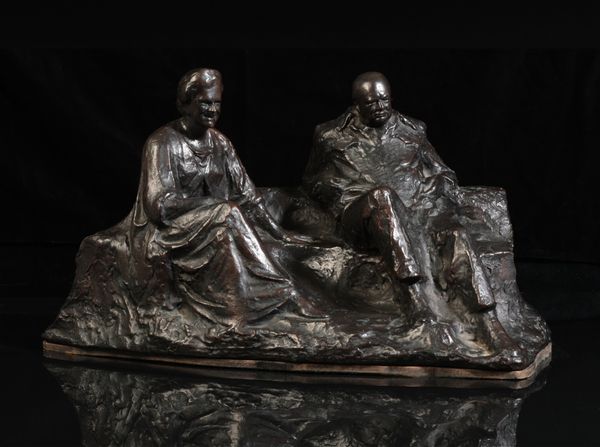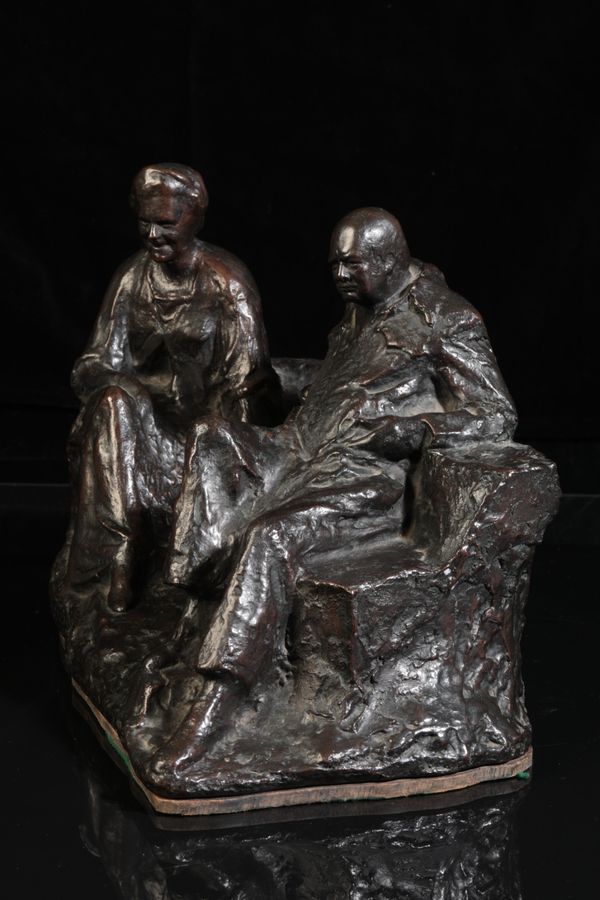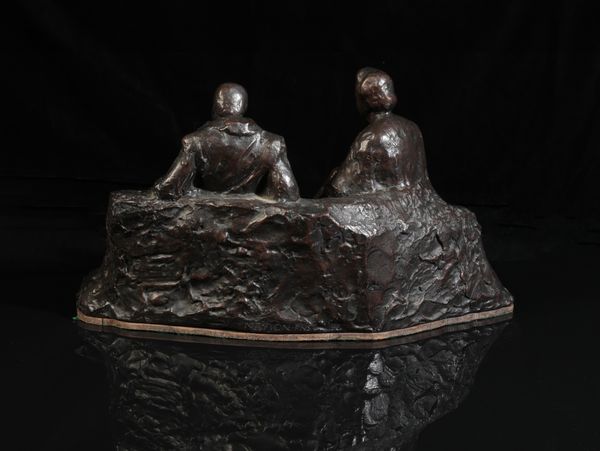A bronze study of Sir Winston Churchill, KG, OM, CH, TD, DL, FRS, RA (1874-1965) and Clementine Ogilvy Spencer Churchill, Baroness Spencer-Churchill, GBE (1885 – 1977), modelled after the full-scale work now in situ in the grounds of Chartwell, the Churchill’s home in Kent, circa 1978, number three from the edition of 15, signed “Nemon FN5” to the reverse, 44.5cm wide x 24cm high x 23cm deep
Provenance: The Collection of Peter AB Johnson, Trustee of the Churchill Statue Fund.
| Condition Report: | click here |
| Estimate: | £25,000 - £35,000 |
| Hammer price: | £50,000 |
Oscar Nemon had approached Peter Johnson to find a suitable home for the monumental work. The first suggestions were Hyde Park and the Cabinet War Rooms, but it was decided, with the agreement of the National Trust, that the sculpture should sit in the grounds of Churchill’s beloved Chartwell. A charity was established, the Churchill Statue Fund, to sell the reduced size bronzes for £5,000 each, to raise the necessary amount for the esteemed Morris Singer Foundry of Basingstoke to cast the monumental bronze. This was a great success, with examples sold to the likes of Michael Heseltine and Jonathan Aitken. The endeavour was so successful in fact, that the organisers could afford to present one copy to Margaret Thatcher and another to Lady Soames, the daughter of Sir Winston and Lady Churchill. In fact, it was Peter Johnson that personally delivered the bronze to Lady Soames, remarking “When I arrived at Sloane Court West, a voice from above, that could only be the daughter of the great Sir Winston Churchill called out “The lift has broken down, but there is a glass of champagne waiting for you” after carrying the 8lb maquette up several flights of stairs, I certainly needed that glass”.
Oscar Nemon
Oscar Nemon was born in Osijek, a small market town in Croatia, in 1906. While at secondary school he demonstrated exceptional talent as a draughtsman and was advised to specialise in drawing and painting. However, the young Nemon found the approach to art at his gymnasium too formulaic, and did not want to conform to its structured way of teaching.
At the age of fourteen, Nemon began to experiment with sculpture, having developed a fascination with a piece encountered on his travels. Inquiring how it was made, he was advised to “Go to the brickworks, where you will find plenty of clay, and make something.”
After taking his baccalaureat in 1923, Nemon left Osijek for the greater opportunities and challenges of Vienna, where he continued to sculpt and study, and develop his innate talent for portraiture. During this initial period his work was both inspired and influenced by Ivan Mestrovic, who later became both a friend and mentor.
In Vienna Nemon’s uncle owned a bronze factory, enabling him to cast his work as it was completed. Already an admirer of Sigmund Freud, whose writings would profoundly influence Nemon’s own thinking, he was able to persuade Freud to sit for him, becoming the first and only person to sculpt the analyst from life.
From Vienna Nemon moved to Paris, and then to Brussels in the early 1930’s. Here, while studying sculpture at the Académie des Beaux Arts he won the Gold Medal for Sculpture, and shared a house with René Magritte. Continuing to develop his more personal figurative work, Nemon also established a style of portraiture that was powerful and intensely evocative of the character of the sitter. An exhibition of Nemon’s sculptures was held at the Palais des Beaux Arts in Brussels in 1932, the success of which led to a series of distinguished commissions, his sitters including King Albert I and Queen Astrid, the then Belgian Prime Minister Van de Velde, and future Prime Minister Henri Spaak, who also became a close friend.
Nemon then moved to England in 1938, intending to go to America, but the war intervened. Based in London and Oxford, Nemon rapidly established himself as an artist of distinction. Here H.M. the Queen, H.M. the Queen Mother, and Prince Phillip all modelled for Nemon, who was granted a studio in St James’s Palace, and whose last sitter at the time of his death in 1985 was Diana, Princess of Wales.
Other distinguished sitters included General Eisenhower, President Truman, Lord Beaverbrook, Field Marshal Montgomery, Ernst Chain, Lord Alexander and Earl Mountbatten, together with Lord Shinwell, Harold Macmillan and Lady Thatcher. There were few from this post-war period to whom he devoted more attention than Sir Winston Churchill, whom he admired deeply, and sculpted from life on numerous occasions.
Nemon modelled in clay, directly from life, subsequently casting his work first in plaster and then in bronze or occasionally marble. Gifted with immense personal charm and delicacy, he would amuse and draw out his sitters with a series of stories and anecdotes which helped produce the extraordinarily animated and revelatory impressions which characterise his portraiture. Although Churchill originally warned Nemon “If you want to lose a friend, do his portrait”, during the course of their many sittings, Churchill and Nemon established a close relationship, becoming personal friends, to the extent that Churchill resolved to attempt Nemon’s head while the sculptor was working on his own. Nemon later remembered how.
“When he (Churchill) became excited about the difficulties in which he found himself, his cigar began to come to pieces in his mouth and soon he was roaring like a lion over its prey. He shouted at me ‘How on earth can I work when you keep moving?’ In the interest of continuing peace between us, I kept still after that and, by doing so, I lost an opportunity of making a real study of him - a sad loss but almost inevitable because he was a restless and most unwilling sitter.”
Nemon had Churchill’s image of him cast in bronze, and wrote to Churchill “I beg you not to underrate the artistic value of this work which would be considered by any expert as outstanding for the first attempt.”
Nemon’s statues of Churchill stand in the Members’ Lobby of the House of Commons, the Guildhall, Blenheim, the National Portrait Gallery and the Cabinet War Rooms. One of his marble busts of Churchill is at Windsor Castle. Other of Nemon’s Churchill sculptures and busts can be found in over twenty capital and major cities round the world from Moscow to Washington.
The bronze appears to be in good condition with no obvious signs of any damage or restoration and has an attractive patina.





